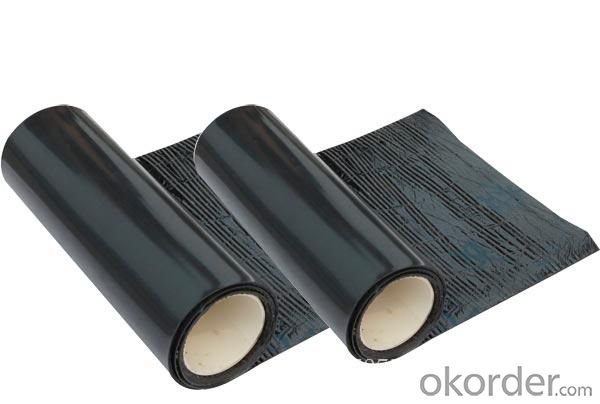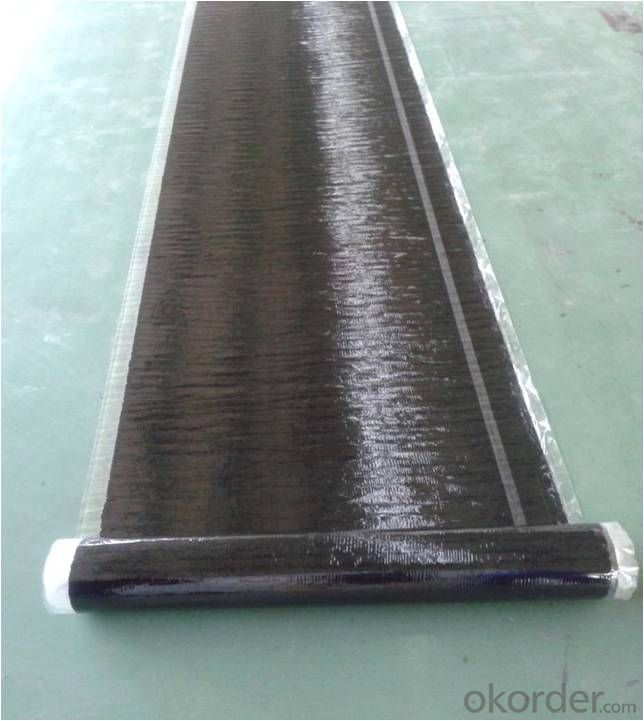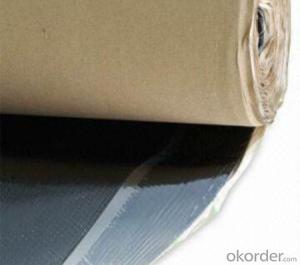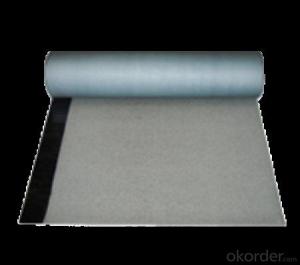SBS Membrane Smooth for Waterproof System
- Loading Port:
- Qingdao
- Payment Terms:
- TT or LC
- Min Order Qty:
- 9000 m²
- Supply Capability:
- 100000 m²/month
OKorder Service Pledge
OKorder Financial Service
You Might Also Like
SBS Membrane Smooth for Waterproof System
Description Of SBS Membrane Smooth for Waterproof System:
1. TPO Membrane Smooth is made from Thermoplastic polyethylene hydrocarbons , which is for waterproofing of exposed and non-exposed applications.
2. TPO Membrane Smooth adopts the world-advanced equipment of cold feeding extrusion and continuous vulcanization technology.
3. TPO Membrane Smooth is of high elasticity among high polymer waterproof materials and becomes a world-popular waterproofing material.
Main Features of SBS Membrane Smooth for Waterproof System:
1. Excellent physical and mechanical performance
2. High tearing resistance
3. Good deformation adaptability
4. High puncture resistance
5. High aging resistance
6. UV resistance
Specifications of SBS Membrane Smooth for Waterproof System:
Material | SBS modified asphalt impregnated and coated tire base |
Size | 1.2m (width)*20m (length) or customized, weldable type 2.05m |
Thick | 1.2mm, 1.5mm, |
Type | Smooth |
Pattern | Non-reinforced (homogeneous) |
Certificate | ISO9001/14001 |
Applications of SBS Membrane Smooth for Waterproof System:
1.Roofs, Basement
2. Industrial and civil building waterproofing
3. Geosynthetic liner for swimming pool, channels, irrigation system
IMages of TPO Membrane Smooth for Waterproof System:



FAQ:
1. What are we supplying?
We are specialized in producing Colorful Asphalt Roof Shingle, SBS/APP modified bitumen waterproof membrane, Self adhesive bitumen waterproof membrane, PVC waterproofing membrane, EPDM rubber roofing membrane, Single Component Polyurethane Waterproof Coating, and Spray Polyurea Waterproof Coating
.
2. How Many years experience do we have?
We have been exported to more than 15 countries in the past 10 years.
3. How long do we usually reply your request?
We always reply our customer within 12 hours.
- Q:Is a waterproofing membrane environmentally friendly?
- Yes, a waterproofing membrane can be considered environmentally friendly. Waterproofing membranes are designed to prevent water leakage and damage to structures, which can contribute to the longevity of a building and reduce the need for repairs or replacements. This can result in a reduction in construction waste and the overall environmental impact of the building industry. Furthermore, some waterproofing membranes are made from eco-friendly materials, such as recycled content or bio-based materials, which can help reduce the carbon footprint associated with their production. Additionally, these membranes can be designed to be recyclable or biodegradable, further reducing their environmental impact at the end of their life cycle. Moreover, by preventing water infiltration, waterproofing membranes can help protect the structural integrity of buildings, preventing moisture-related issues such as mold growth and rot. This can contribute to maintaining a healthy indoor environment and reducing the need for energy-intensive remediation measures. It is important, however, to consider the specific characteristics and certifications of a waterproofing membrane to assess its environmental friendliness accurately. Look for certifications such as LEED (Leadership in Energy and Environmental Design) or products that have undergone life cycle assessments to ensure that they meet rigorous environmental standards. In summary, while not all waterproofing membranes may be inherently environmentally friendly, the use of certain materials and the prevention of water damage can make them a sustainable choice for building projects.
- Q:Can a waterproofing membrane be used on precast wood surfaces?
- Yes, a waterproofing membrane can be used on precast wood surfaces. Waterproofing membranes are commonly used to protect various types of surfaces, including wood, from water damage. These membranes are designed to create a barrier that prevents water from seeping through and causing structural issues or rot in the wood. By applying a waterproofing membrane to precast wood surfaces, you can effectively protect the wood from moisture and prolong its lifespan. However, it is important to ensure that the membrane is compatible with wood and follow the manufacturer's guidelines for application to achieve the best results.
- Q:Can a waterproofing membrane be used on tile surfaces?
- Indeed, tile surfaces can be protected using a waterproofing membrane. This membrane, a slim material layer, serves the purpose of obstructing the infiltration of water or moisture into the underlying surface. Typically utilized in locations with elevated water exposure levels, such as bathrooms, showers, or outdoor areas, a properly applied waterproofing membrane forms a safeguard for the tile surface, thwarting water damage and averting problems like mold, mildew, or tile deterioration. It is crucial to ascertain that the waterproofing membrane is suitable for the specific type of tile employed, and that it is installed accurately to guarantee optimal effectiveness.
- Q:Is a waterproofing membrane compatible with different types of roofing materials?
- Yes, a waterproofing membrane is compatible with different types of roofing materials. It can be used with various roofing systems such as asphalt shingles, metal, concrete, or tile roofs. The purpose of a waterproofing membrane is to create a barrier against moisture, regardless of the roofing material used.
- Q:Can a waterproofing membrane be applied to concrete?
- Yes, a waterproofing membrane can be applied to concrete. In fact, it is a common and effective method used to protect concrete structures from water damage. The membrane is typically made of a flexible material, such as rubber or polymer, that is applied to the surface of the concrete. This creates a barrier that prevents water from penetrating the concrete and causing deterioration or structural damage. Waterproofing membranes can be applied to various types of concrete structures, including basements, foundations, roofs, and balconies. The application process typically involves cleaning and preparing the concrete surface, applying a primer if necessary, and then applying the membrane using a brush, roller, or spray. It is important to follow the manufacturer's instructions and ensure proper installation to achieve the desired level of waterproofing.
- Q:Can a waterproofing membrane be used in areas with high humidity?
- Certainly! In areas with high levels of humidity, it is possible to utilize a waterproofing membrane. In reality, the presence of excessive humidity often adds to the necessity for waterproofing due to the potential accumulation of moisture and subsequent water damage. The purpose of waterproofing membranes is to establish a barricade that hinders the penetration of water through various surfaces like walls or floors. These membranes are capable of effectively safeguarding against moisture and water infiltration, which holds particular significance in locations with elevated humidity where the threat of water damage is amplified. By implementing a waterproofing membrane, you can significantly decrease the probability of encountering issues such as mold, mildew, and other complications related to moisture within these environments.
- Q:Can a waterproofing membrane be applied in cold weather?
- Applying a waterproofing membrane in cold weather is possible. However, there are certain factors to consider. It is essential to choose a membrane specifically designed for cold weather use, as some may not work well in low temperatures. The curing process of the membrane can be affected by cold weather, so it is crucial to adhere to the temperature limitations and application techniques provided by the manufacturer. Before applying the membrane, the surface must be clean and dry to prevent interference from moisture or ice. In cold weather, the membrane may take longer to cure and reach its maximum performance. Therefore, it is advisable to allow ample time for drying and curing before exposing it to water or other stressors. Additionally, it is worth noting that extreme cold temperatures can hinder the installation process and the overall effectiveness of the waterproofing system. Therefore, it is recommended to seek guidance from a professional waterproofing contractor experienced in working under such conditions to ensure the best outcomes.
- Q:Can a waterproofing membrane be used in conjunction with tile or stone installations?
- Certainly! When installing tile or stone, it is highly recommended to utilize a waterproofing membrane. This membrane serves as a barrier, preventing water from seeping into the underlying layers and causing damage. It is especially beneficial in wet areas, such as bathrooms, showers, and kitchen backsplashes. There are different types of waterproofing membranes available, such as liquid-applied, sheet, and fabric membranes. These can be applied to the substrate before installing the tile or stone, creating a waterproof layer that keeps the area dry and free from water-related issues. In addition to safeguarding against water damage, a waterproofing membrane also helps to prevent the growth of mold and mildew, which can be detrimental to both the installation and the health of those using the space. It is essential to note that proper installation of the waterproofing membrane is crucial for its effectiveness. Following the guidelines and best practices provided by the manufacturer ensures a tight seal and complete coverage. Overall, integrating a waterproofing membrane with tile or stone installations is a prudent decision. It enhances the project's durability and longevity while providing peace of mind against potential water damage.
- Q:About asphalt waterproofing membrane
- 4, SBS membrane is commonly referred to as a polymer modified asphalt coil, there are other APP, APAO and other modified asphalt membrane.
- Q:Construction Measures for Waterproof Coil in Winter
- 2. Master the hot melt paving points. Hot melt coil construction requirements of the heating width should be uniform, heating nozzle from the coil surface to be appropriate, 0.5m or so. Winter construction temperature is low, hot-melt time than the room temperature to be more, hot-melt to the surface of the membrane is bright, or melting is not enough. Such as beyond the degree of light overheating melting, the polymer modified asphalt easy to aging zoom, adverse bonding, but can not penetrate burned, grasp the hot melt to be strong bonding. When the sheet is rolled, the seam must be spilled over the adhesive to verify that the paste is tight, and the spilled adhesive is scrapped and the necessary measures to strengthen the seam. Coil large hot melt paving the same attention should be paid to the air inside the coil.
1. Manufacturer Overview |
|
|---|---|
| Location | |
| Year Established | |
| Annual Output Value | |
| Main Markets | |
| Company Certifications | |
2. Manufacturer Certificates |
|
|---|---|
| a) Certification Name | |
| Range | |
| Reference | |
| Validity Period | |
3. Manufacturer Capability |
|
|---|---|
| a)Trade Capacity | |
| Nearest Port | |
| Export Percentage | |
| No.of Employees in Trade Department | |
| Language Spoken: | |
| b)Factory Information | |
| Factory Size: | |
| No. of Production Lines | |
| Contract Manufacturing | |
| Product Price Range | |
Send your message to us
SBS Membrane Smooth for Waterproof System
- Loading Port:
- Qingdao
- Payment Terms:
- TT or LC
- Min Order Qty:
- 9000 m²
- Supply Capability:
- 100000 m²/month
OKorder Service Pledge
OKorder Financial Service
Similar products
New products
Hot products
Related keywords






























